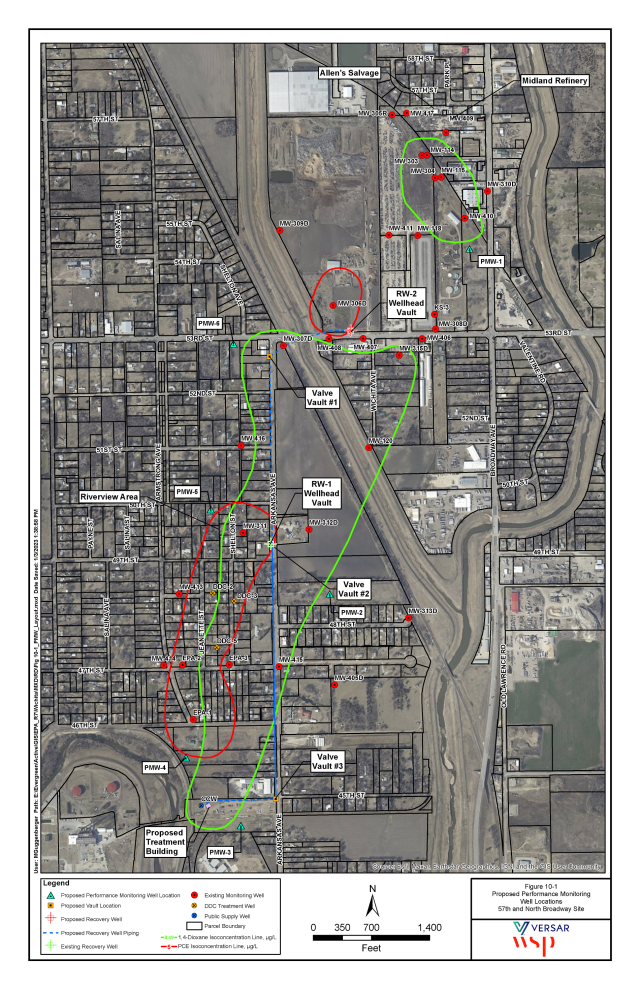57th and North Broadway Streets Superfund Site, Wichita, Kansas - Fact Sheet, April 2023
Remedial Design Completion

About the Site
The 57th and North Broadway Streets Superfund Site consists of three Operable Units (OUs). OU1 addressed site-wide groundwater and soil contamination. The selected remedies in the Sept. 29, 1999, Record of Decision included groundwater treatment using in-well strippers, monitoring, and institutional controls; and the soil remedy included soil vapor extraction. OU2 addressed remedial actions in the Riverview Neighborhood portion of the site. Impacted residences were connected to the Wichita public water supply system. In 2018, OU3 was established and replaced OU1 and OU2 to address all site soil and groundwater contamination and developed further actions necessary to clean up the site. To review Administrative Records and other cleanup documents for this site, please visit EPA’s Site Profile page.
Site Milestones
EPA finalized the Remedial Design at the site in March 2023. In this phase of the Superfund site cleanup process, the technical specification for cleanup remedies and technologies are developed. Remedial Action follows the Remedial Design phase and involves the actual construction or implementation of the cleanup. There are two components to the Remedial Design. The first action is at the source area: digging and removing contaminated soil down 20 to 25 feet below ground surface. Once the contaminated soil is removed from the source area, a chemical oxidant will be applied at the bottom of the excavation area to address any residual contamination. The second component is a Ground Water Extraction System (GETS), which captures the contaminated groundwater, cleans the water, and is then discharged into the municipal water supply. As of spring 2023, EPA received funding through the Infrastructure Investment and Jobs Act to implement the remedial activities described above at the site.
Is My Drinking Water Safe?
Yes. The Public Works and Utilities Public Water Supply provides water that meets all state and federal drinking water health standards. To learn more, visit Wichita's Public Water Supply page.
What is Perchloroethylene (PCE)?
Perchloroethylene (PCE, sometimes called perchloroethene, tetrachloroethylene, tetrachloroethene, or PERC) is considered a contaminant of concern (COC) at the site. COCs are chemicals that need to be addressed by a cleanup action because they are a potential threat to human health or the environment. PCE is a volatile organic compound, or VOC. This kind of organic chemical compound evaporates under normal indoor temperatures and pressure. PCE was once widely used in dry cleaning and metal degreasing. The Centers for Disease Control and Prevention’s Agency for Toxic Substances and Disease Registry (ATSDR) has a series of summaries about contaminants, called ToxFAQs, where you can find a ToxFAQ on PCE (listed as tetrachloroethylene).
What is Trichloroethylene (TCE)?
Trichloroethylene (TCE, also called trichloroethene) is considered a contaminant of concern (COC) at the site. COCs are chemicals that need to be addressed by a cleanup action because they are a potential threat to human health or the environment. TCE is a volatile organic compound, or VOC. This kind of organic chemical compound evaporates under normal indoor temperatures and pressure. TCE is part of some industrial and commercial processes, including in dry cleaning facilities. It is one of the most common contaminants at Superfund sites. The Centers for Disease Control and Prevention’s Agency for Toxic Substances and Disease Registry (ATSDR) has a summary about contaminants, called ToxFAQs, where you can find ToxFAQs on TCE.
What are Dioxins/Furans?
Dioxins/furans are considered a contaminant of concern (COC) at the site. COCs are chemicals that need to be addressed by a cleanup action because they are a potential threat to human health or the environment. Dioxins and furans are a short name for a family of toxic substances that share a similar chemical structure. They are created when other chemicals or products are made. For example, they are created when herbicides are made; when wood and household waste products are burned; and when pulp is bleached to make paper. The Centers for Disease Control and Prevention’s Agency for Toxic Substances and Disease Registry (ATSDR) has a series of summaries about contaminants, called ToxFAQs, where you can find ToxFAQs on dioxins (listed as chlorinated dibenzo-p-dioxins) and furans (listed as chlorodibenzofurans).
Information Repositories
Site project information is available to the public at web repositories. Please visit EPA’s Site Profile page (see Site Documents & Data). If you do not have internet access, you can view site documents online at this location:
Park City Public Library
2107 E. 61st Street North
Park City, KS 67219
316-744-6318
EPA Contact Information
David Wennerstrom
Remedial Project Manager
Superfund and Emergency Management Division
11201 Renner Boulevard
Lenexa, KS 66219
Phone: 913-551-7996
Toll-free: 1-800-223-0425
Email: wennerstrom.david@epa.gov
Pamela Houston
Community Involvement Coordinator
Office of Public Affairs
11201 Renner Boulevard
Lenexa, KS 66219
Phone: 913-551-7699
Toll-free: 1-800-223-0425
Email: houston.pamela@epa.gov
